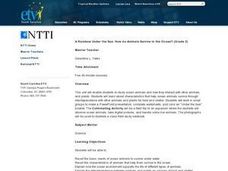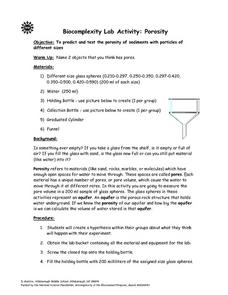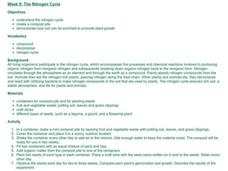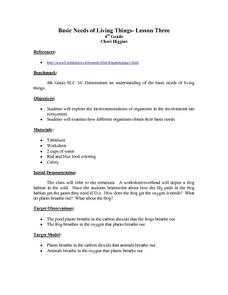Curated OER
A Rainbow Under the Sea: How do Animals Survive in the Ocean?
Second graders read books, watch videos, complete worksheets and participate in class discussions about ocean animals. They, in groups, design PowerPoint presentations on selected marine animals.
Curated OER
Investigating Local Ecosystems
Pupils investigate the habitats of local plants and animals. They explore some of the ways animals depend on plants and each other. Students observe living organisms in a local ecosystem and create detailed drawings and descriptions of...
Curated OER
Porosity
Middle schoolers predict and test the porosity of sediments with particles of different sizes. They name two objects that they think has pores. Students define the term porosity and pores. They comprehend that an aquifer is the porous...
Curated OER
Structure and Function of Seeds
Students study the functions of seeds. In this biology lesson plan, students observe the structure of a seed as they show the function of the cotyledons in providing nourishment to the plant during the early times after germination.
Curated OER
Water Cycle Stories
Students explore the water cycle. In this water cycle lesson plan, students simulate the water cycle by placing an ice cube in a Ziploc bag and observing the changes which occur over time. Students record the mass of the Ziploc bag and...
Curated OER
Life in Space: International Space Station
Students explore the potential challenges of living in space. In this investigative lesson plan students search the Internet to locate 16 nations that are working together to build the Independent Space Station, then they divide...
Curated OER
Changing Weather: Comparing Climate from Voyageur Times to Today
Fifth graders compare climates. In this weather lesson, 5th graders observe and record weather observations and discuss the impact of weather on people. Students also discuss the concept of global warming and determine how weather...
Curated OER
Purification of Water
Students study the process of water purification and explain why it was important to treat it. In this water purification lesson students purify drinking water and explain the factors that affect water quality.
Curated OER
Homemade Ice Cream
Young scholars investigate nutrition by creating ice cream in class. In this cooking instructional activity, students define the ingredients in ice cream and discuss how they form together to create a delicious treat. Young scholars...
Curated OER
Oxidation And Corrosion
Students investigate the concepts of oxidation and corrosion. They identify different metals and forms of corrosion.
Curated OER
The Nitrogen Cycle
Students design and create a compost pile in order to study the Nitrogen Cycle. They then use the scientific method to determine if plants grow better when they add organic matter from their compost pile to the plant's soil.
Curated OER
A Matter of Fact
Third graders define matter as anything that takes up space and has mass, recognize, through experimentation and observation, that matter exists in three forms, including solid, liquid, and gas, and discuss characteristics of each form...
Curated OER
Reduce, Reuse, Recycle
Fourth graders discover the differences between: reduce, reuse, and recycle by performing hands on examinations. They list what would happen to the soil if we allowed the earth to wash away and briefly discuss the meaning of erosion.
Curated OER
Basic Needs of Living Things-Lesson Three
Fourth graders explore the interconnectedness of organisms in the environment and examine how different organisms obtain their basic needs. They discuss a frog's habitat and what is found in it. Students discuss the processes of...
Curated OER
Kamchatka: Just Gushing with Geysers!
Young scholars explore geysers. They identify the parts of the geyser and how it works. Students create a working model of a geyser. They write a brief summary about their geyser.
Curated OER
Water Filtration
Students explore, analyze, study and demonstrate the procedures that municipal water plants may use to purify water for drinking. They cover the clean water processes of aeration, coagulation, sedimentation, filtration and disinfection.
Curated OER
Wacky Water Critters
Students visit a local creek or stream. They collect water samples from the creek and observe and sort the "water critters" they find in the sample, observing smaller organisms under a microscope if necessary. They identify each organism...
Curated OER
Groundwater Flow Demonstration Model
Students investigate the concept of groundwater that includes aquifers, groundwater flow, and the water table. They participate in activities using a flow demonstration model. Its use engages all types of learners because of its hands on...
Curated OER
String Telephone
Students investigate sound as a form of energy. For this energy, forces, and sound lesson plan, students work in pairs to examine how sound travels through solid things as they construct a telephone exchange system using string and tin.
Curated OER
Clouds in a Jar
Fifth graders create a cloud jar so that they can observe that clouds are made of tiny droplets of water. After observing the cloud jar, they record their observations on a worksheet in written form explaining that clouds are made of...
Curated OER
Summer Scientists
In this lesson plan, students discuss and reocrd what makes an object living or nonliving. The students then chart the lists of living and nonliving objects. Teacher allows students oportunity to go outside and look for living and...
Curated OER
Caterpillar Habit
Young scholars watch a caterpillar change and become a butterfly. In this lesson about the life cycle of a caterpillar and a butterfly, students prepare and maintain the habitat of the caterpillar. Young scholars observe the stages of...
Curated OER
Invisible Ink - Demonstration
Learners observe a demonstration that shows that the indicator, phenolphthalein, is a chemical that displays different colors depending on either the acidity or the basicity of the environment. They use the substance to reveal secret...























